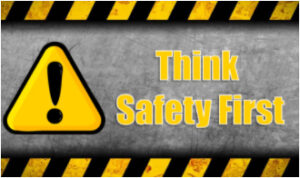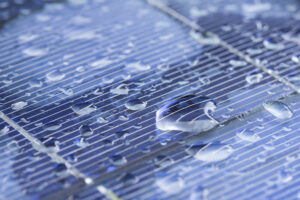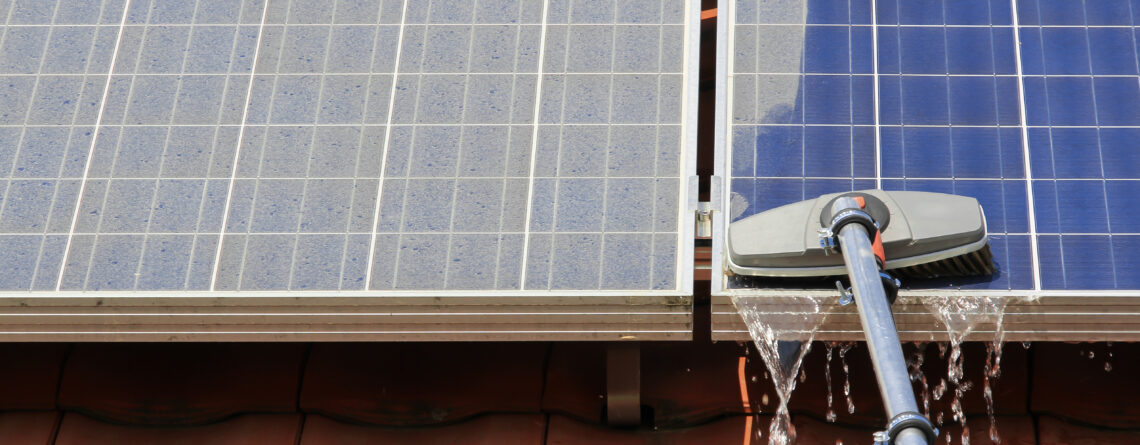How to Clean Your Solar Panels
Dirty solar panels are less efficient because the dirt blocks some of the available sunlight, so keeping them clean will keep them operating at peak efficiency. The frequency of cleaning will depend on your location and the time of year. Seasonal rain and snow melt usually washes off dust, pollen, animal droppings and other grime that build over time. But if you are in an area that gets little precipitation, or where you seasonally get high soiling from things like pollen or nearby agricultural activity, you will want to clean them periodically.
Safety First

Cleaning a pole or ground mount system is relatively easy and safe. However, if you have a rooftop solar system, and particularly on a multi-story building, it is important that you exercise caution when cleaning your solar panels.
If at all possible, clean your solar panels from the ground. If you can’t, use a secure ladder, scaffolding or a lift, and proper fall protection gear to keep yourself safe.
If in Doubt, Hire a Professional
Don’t expose yourself to any risk. If you have any doubts about whether or not you can safely clean your solar panels, hire a professional. Many window washing companies now offer a solar panel cleaning service.
Solar Panel Cleaning Tips
- Clean early in the morning, in the evening or on an overcast day when your solar panels are cool. Cleaning them while they are hot will result in rapid evaporation and smearing. In addition, rapid cooling of the aluminum frames could result in module damage.
- Turn your system off before you start cleaning to protect it. If you don’t know how to turn it off, refer to your owner’s manual or call your solar contractor.
- Wear gloves to avoid leaving dirt or fingerprints on your solar panels.
- Use water and a soft, non-abrasive brush or a squeegee with a telescoping handle. A flow-through handle will also make cleaning a lot easier.
- Avoid using hard or mineral rich water as it can damage solar panels over time. If your tap water is hard you can buy an inexpensive water-softening hose attachment.
- If there is a stubborn film, either from pollen or other airborne particulates you can use the following types of cleaning products:
- One that is non-Abrasive, pH Neutral, and Bio-degradable.
- Any type of commercial glass cleaners or alcohol/ethanol/methanol brand can be used.
- A homemade option is a mixture of one part vinegar and eight parts water mixed with a small amount of gentle, non-abrasive soap. Be aware that soap can leave a residue that reduces the amount of power your solar panels produce. Always use soap sparingly and be sure to rinse your solar panels thoroughly after washing.
- If using a high-pressure hose water nozzle, don’t get too close to your solar panels. They are extremely durable, but you don’t want to risk damaging them.

The Steps
- Remove caked on materials first. The modules will clean easier without this additional material present.
- For a few panels: wet the module glass with the cleaning solution and let it stand for five minutes. Then wet them again and use a soft sponge or seamless cloth to wipe the glass surface in a circular motion.
- For larger systems: wet the module glass with the cleaning solution and let it stand for five minutes. Then rinse them with water using a high pressure hose nozzle (do not use a pressure washer) or regular pressure water and a soft squeegee.
- To remove tough, caked on materials use non-woven fabric – microfiber cloths work great. Note that careful, focused cleaning is better than aggressive scrubbing that might scratch the panel.
NEVER:
- Clean on, around or under your solar panels with bleach or other caustic chemicals that can damage your solar panels.
- Use tools like blades, knives, steel wool, high pressure washers, abrasive brushes, cleaners, polishers, bleach or substances that contain sodium hydroxide, benzene, nitro-thinners, or alkali chemicals.
- Use products like Rain-X on your solar panels. Rain-X specifically lists that their product should not be used for solar applications.

